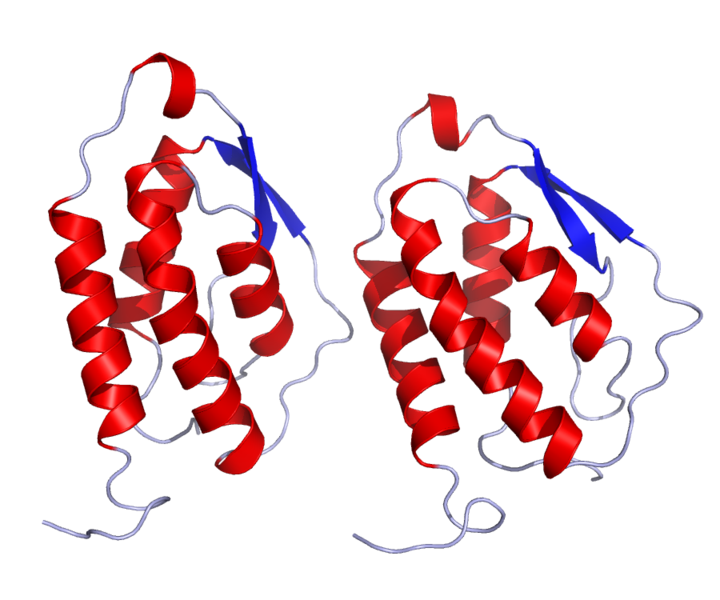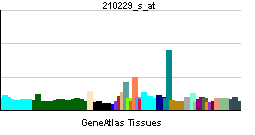Granulocyte macrophage colony stimulating factor
 | |
| Clinical data | |
|---|---|
| ATC code | |
| Identifiers | |
| |
| CAS Number | |
| DrugBank | |
| E number | {{#property:P628}} |
| ECHA InfoCard | {{#property:P2566}}Lua error in Module:EditAtWikidata at line 36: attempt to index field 'wikibase' (a nil value). |
| Chemical and physical data | |
| Formula | C639H1006N168O196S8 |
| Molar mass | 14434.5 g/mol |
| Colony stimulating factor 2 (granulocyte-macrophage) | |||||||||||
|---|---|---|---|---|---|---|---|---|---|---|---|
 PDB rendering based on 2gmf | |||||||||||
| Identifiers | |||||||||||
| Symbols | CSF2 ; GMCSF; MGC131935; MGC138897 | ||||||||||
| External IDs | Template:OMIM5 Template:MGI HomoloGene: 600 | ||||||||||
| |||||||||||
| RNA expression pattern | |||||||||||
 | |||||||||||
| More reference expression data | |||||||||||
| Orthologs | |||||||||||
| Template:GNF Ortholog box | |||||||||||
| Species | Human | Mouse | |||||||||
| Entrez | n/a | n/a | |||||||||
| Ensembl | n/a | n/a | |||||||||
| UniProt | n/a | n/a | |||||||||
| RefSeq (mRNA) | n/a | n/a | |||||||||
| RefSeq (protein) | n/a | n/a | |||||||||
| Location (UCSC) | n/a | n/a | |||||||||
| PubMed search | n/a | n/a | |||||||||
Editor-In-Chief: C. Michael Gibson, M.S., M.D. [3]
Overview
Granulocyte-macrophage colony-stimulating factor, often abbreviated to GM-CSF, is a protein secreted by macrophages, T cells, mast cells, endothelial cells and fibroblasts.
Functions
GM-CSF is a cytokine that functions as a white blood cell growth factor. GM-CSF stimulates stem cells to produce granulocytes (neutrophils, eosinophils, and basophils) and monocytes. Monocytes exit the circulation and migrate into tissue, whereupon they mature into macrophages. It is thus part of the immune/inflammatory cascade, by which activation of a small number of macrophages can rapidly lead to an increase in their numbers, a process crucial for fighting infection. The active form of the protein is found extracellularly as a homodimer.
Genetics
The gene has been localized to a cluster of related genes at chromosome region 5q31, which is known to be associated with interstitial deletions in the 5q- syndrome and acute myelogenous leukemia. Other genes in the cluster include those encoding interleukins 4, 5, and 13.[1]
Glycosylation
Human granulocyte macrophage colony-stimulating factor is glycosylated in its mature form. The glycosylation sites are reported to be at amino acid residues 23 (leucine), 27 (asparagine), and 39 (glutamic acid) (see US Patent No. 5,073,627).[2]
Clinical significance
GM-CSF is also known as molgramostim or, when the protein is expressed in yeast cells, sargramostim (Leukine®).
GM-CSF is used as a medication to stimulate the production of white blood cells following chemotherapy. It has also recently been evaluated in clinical trials for its potential as a vaccine adjuvant in HIV-infected patients. The preliminary results have been promising but GM-CSF is not presently FDA-approved for this purpose.
Leukine
Leukine is the trade name of sargramostim manufactured by Berlex Laboratories, a subsidiary of Schering AG. Its use was approved by U.S. Food and Drug Administration for acceleration of white blood cell recovery following autologous bone marrow transplantation in patients with non-Hodgkin's lymphoma, acute lymphocytic leukemia, or Hodgkin's disease in March 1991.[3] In November 1996, the FDA also approved sargramostim for treatment of fungal infections and replenishment of white blood cells following chemotherapy.[4]
Controversy
Berlex funded a study that ran in the May 26 2005 issue of the New England Journal of Medicine which concluded that, GM-CSF did produce significantly more remissions in Crohn's disease than those who received a placebo in the study, and it also decreased disease severity and improved quality of life.[5]
The study's lead author, Joshua Korzenik of Harvard Medical School and Massachusetts General Hospital, is a paid consultant for Berlex , and co-inventor of the patent which is owned by Washington University.[6] Korzenik created a "firewall" to protect the integrity of the study, consisting of two committees to review the study results and process as well and sending trial data to outside clinicians for review.[6]
See also
References
- ↑ "Entrez Gene: CSF2 colony stimulating factor 2 (granulocyte-macrophage)".
- ↑ http://www.google.com/patents?vid=USPAT5073627&dq=5,073,627
- ↑ [1] Details of Approved Claims by Line of Therapy, Approved Claims for 1991, FDA.gov
- ↑ [2] Drugs Approved by the FDA, Drug Name: Leukine (sargramostim), CenterWatch.com
- ↑ Korzenik J, Dieckgraefe B, Valentine J, Hausman D, Gilbert M (2005). "Sargramostim for active Crohn's disease". N Engl J Med. 352 (21): 2193–201. PMID 15917384.
- ↑ 6.0 6.1 "Med school drug pushers: How scientists are selling out to drug companies", by David S. Bernstein, The Phoenix. Published April 12 2006. Accessed 8 Feb 2007.
Further reading
- Esnault S, Malter JS (2002). "GM-CSF regulation in eosinophils". Arch. Immunol. Ther. Exp. (Warsz.). 50 (2): 121–30. PMID 12022701.
- Martinez-Moczygemba M, Huston DP (2003). "Biology of common beta receptor-signaling cytokines: IL-3, IL-5, and GM-CSF". J. Allergy Clin. Immunol. 112 (4): 653–65, quiz 666. doi:10.1016/S0091. PMID 14564341.
- Mroczko B, Szmitkowski M (2005). "Hematopoietic cytokines as tumor markers". Clin. Chem. Lab. Med. 42 (12): 1347–54. doi:10.1515/CCLM.2004.253. PMID 15576295.
- Hamilton JA, Anderson GP (2005). "GM-CSF Biology". Growth Factors. 22 (4): 225–31. doi:10.1080/08977190412331279881. PMID 15621725.
- Tortorella C, Simone O, Piazzolla G; et al. (2007). "Age-related impairment of GM-CSF-induced signalling in neutrophils: role of SHP-1 and SOCS proteins". Ageing Res. Rev. 6 (2): 81–93. doi:10.1016/j.arr.2006.10.001. PMID 17142110.
- Robertson SA (2007). "GM-CSF regulation of embryo development and pregnancy". Cytokine Growth Factor Rev. 18 (3–4): 287–98. doi:10.1016/j.cytogfr.2007.04.008. PMID 17512774.
External links
- http://www.leukine.com/ - Official Leukine web site
- Granulocyte-Macrophage+Colony-Stimulating+Factor at the US National Library of Medicine Medical Subject Headings (MeSH)
- Pages with script errors
- CS1 maint: Multiple names: authors list
- E number from Wikidata
- ECHA InfoCard ID from Wikidata
- Articles without EBI source
- Chemical pages without ChemSpiderID
- Articles without KEGG source
- Articles without InChI source
- Articles without UNII source
- Drugs with no legal status
- Articles containing unverified chemical infoboxes
- Human proteins
- CS1 maint: Explicit use of et al.
- Immunology
- Hematology
- Growth factors